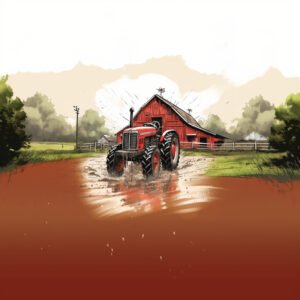Western Washington, with its picturesque landscapes and temperate rainforests, is a haven for nature enthusiasts. However, for farmers raising cattle and horses, the region’s frequent rain showers can lead to a persistent and challenging problem: mud. Excessive mud can pose health risks to livestock, damage pastures, and make farm management a messy endeavor. Let’s delve into the intricacies of mud management in Western Washington, offering solutions tailored for cattle and horse farmers.
Understanding the Mud Challenge
Western Washington’s maritime climate brings significant rainfall, especially during the fall and winter months. This, combined with the region’s clay-heavy soils, can lead to waterlogged pastures and muddy conditions. For cattle and horses:
- Hoof Health: Prolonged exposure to wet conditions can lead to hoof diseases like thrush in horses or foot rot in cattle.
- Pasture Damage: Excessive mud can damage root systems, leading to soil compaction and reduced forage quality.
- Increased Workload: Muddy conditions can make daily chores, from feeding to mucking out, more labor-intensive.
Strategies for Effective Mud Management
- Site Selection: If starting from scratch or considering relocation, choose higher ground with natural drainage. Sloped areas or those with sandy or gravelly soil tend to drain better than flat or clay-heavy regions.
- Gutter and Drainage Systems: Install gutters on all barns, shelters, and outbuildings to divert rainwater. Additionally, consider French drains or other drainage solutions to channel water away from pastures and high-traffic areas.
- Geotextile Fabric and Footing: In high-traffic areas, such as gateways or feeding spots, lay down geotextile fabric covered with several inches of gravel or coarse sand. This creates a permeable layer that separates the soil from the surface material, reducing mud formation.
- Rotational Grazing: Divide pastures into smaller sections and rotate cattle and horses regularly. This prevents overgrazing, reduces soil compaction, and allows pastures to recover.
- Sacrifice Areas: Designate specific areas where livestock can be confined during particularly wet periods. These “sacrifice areas” might become muddy, but they protect the rest of the pasture. Ensure these areas are equipped with proper shelter and drainage.
- Regular Manure Management: Accumulated manure can contribute to mud issues. Regularly remove manure from pastures, paddocks, and sacrifice areas. Consider composting the manure for future use as a soil amendment.
- Plant Cover Crops: In areas prone to mud, consider planting cover crops like ryegrass. These plants can reduce soil erosion, improve soil structure, and absorb excess moisture.
- Hoof Care: Regular hoof cleaning and trimming are essential. Check cattle and horse hooves frequently for signs of disease or damage, and consult with a farrier or veterinarian if issues arise.
- Educate and Collaborate: Join local farming or equestrian groups in Western Washington. Sharing experiences and solutions with fellow farmers can provide new insights and strategies.
Conclusion
Mud management in Western Washington requires a proactive approach, understanding the region’s unique challenges, and implementing tailored solutions. With careful planning, dedication, and the right strategies, cattle and horse farmers can ensure the health of their livestock, the quality of their pastures, and the efficiency of their operations, even in the muddiest of seasons. Remember, while mud might be inevitable, it doesn’t have to be insurmountable.
